Road Kill Rally Rules
Contents
- 20 Road Tiles
- 68 Accessory Cards
- 92 Rally Cards
- 12 Skill Cards
- 57 Shoot Tokens
- 3 Place Tokens
- 18 Wipe Out Tokens
- 40 Pedestrian Minis
- 6 Dice
- 6 Player Dashboards
- 6 Player Cars
- 6 Speed Indicators
- 1 Rulebook
Winning the Game
The winner is the player who has scored the highest number of points at the end of the race. Players score points by killing pedestrians, damaging opponents and crossing the finish line in first, second, or third place. If two players’ scores are identical at the end of the race, the player who crossed the finish line first is the winner. If neither have crossed the finish line the game is a draw.
Game Setup
- Remove the Start and Finish Line road tiles and shuffle the remaining tiles.
- Cut the Finish Line tile into the road tile deck two to four tiles from the bottom.
- For a shorter game cut the Finish Line tile four to eight tiles from the bottom.
- Place the pedestrians, Shoot tokens, Wipe out tokens, Place tokens and dice into piles on the tabletop.
- The Start tile is placed face up in the middle of the table.
- Shuffle the Rally Cards and deal each player seven cards.
- Shuffle the Accessory Cards and deal player eight cards.
- Select a car and take the dashboard of the same color (red, blue, green, yellow, purple or black). Place the speed indicator marker in the 100 MPH (5) box on the dashboard.
- Starting with the youngest player and moving clockwise around the table, configure your race car by placing red, green and yellow accessory cards at the top of your dashboard with the accessory cards in your deck. The colors at the bottom of each accessory card must match the color at top of the dashboard (see illustration on right page).
- Starting with the youngest player and moving clockwise around the table, select a pole position space on the Start road tile (1 - 6). Place your plastic car in the chosen space.
- The player in the lowest pole position (number) draws and places the first road tile. Some road spaces in the newly placed tile contain a colored splatter. Place a pedestrian of the same base color in each of these spaces (green, yellow or red).
- The player in the lowest pole position number (1 - 6) starts the game!
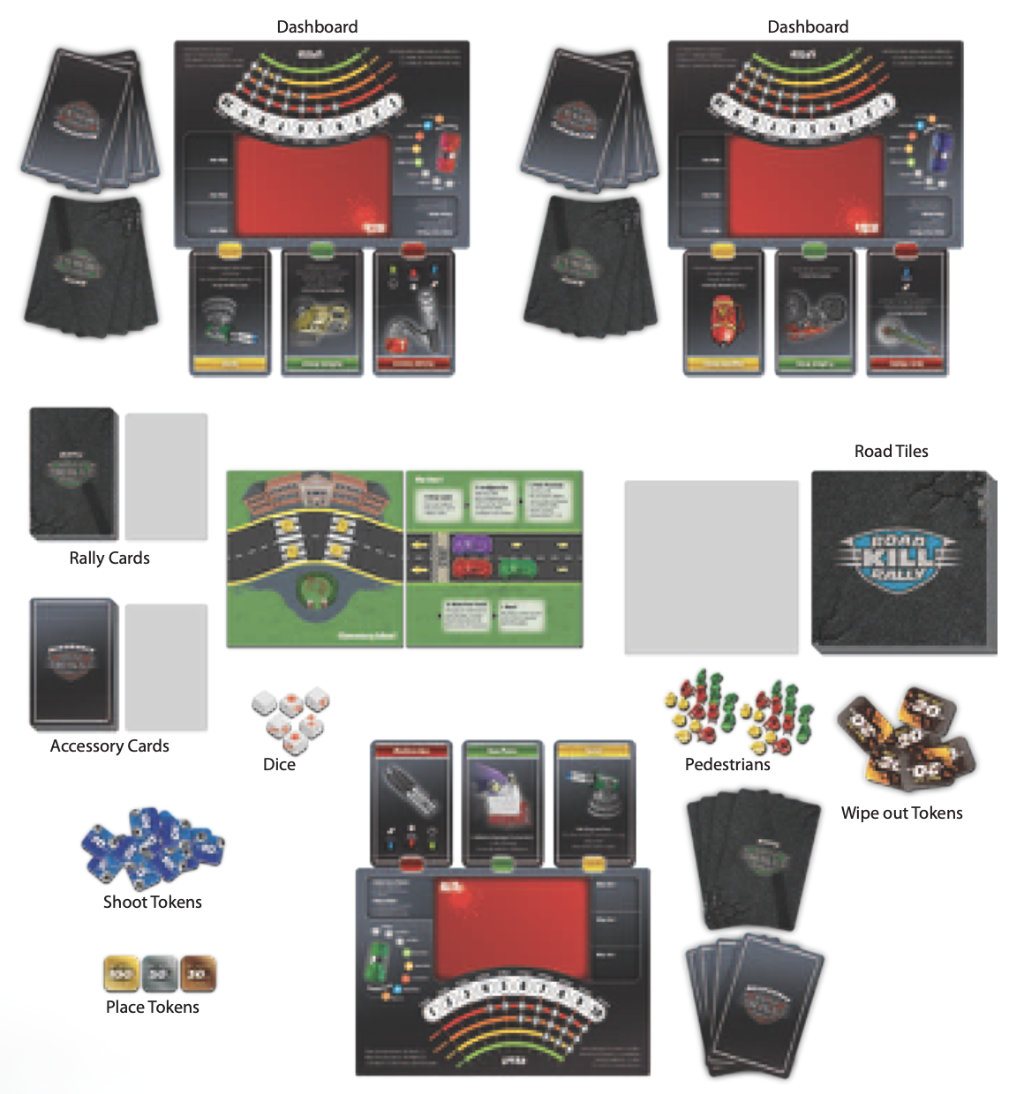
Rolling the Dice
Road-Kill Rally uses special dice to determine the outcome of events. These dice are marked with blood splatters. Each splatter represents one hit.
Whenever a double splatter is rolled, two hits are scored and an additional die is rolled. The splatters from all the dice rolled are added together for a final hit total.
The Game Turn
The game turn consists of three phases:
- Draw Rally Cards
- Set Speed & Move
- Combat
All players perform each phase one at a time. The next phase begins when all players have completed their phase action. In other words, all players draw Rally cards, then all players set speed & move, and then all players attack.
Phase Order
Each phase is performed from the front to the back. The player in the front of the race performs his phase first, followed by the second forward-most player and so on. When two cars are side by side, the player who is moving the fastest goes first. If the players are moving at the same speed, three dice are rolled by each player. The player with the highest number of hits goes first.
- Position (Front first)
- Speed (Fastest first)
- Roll on three dice
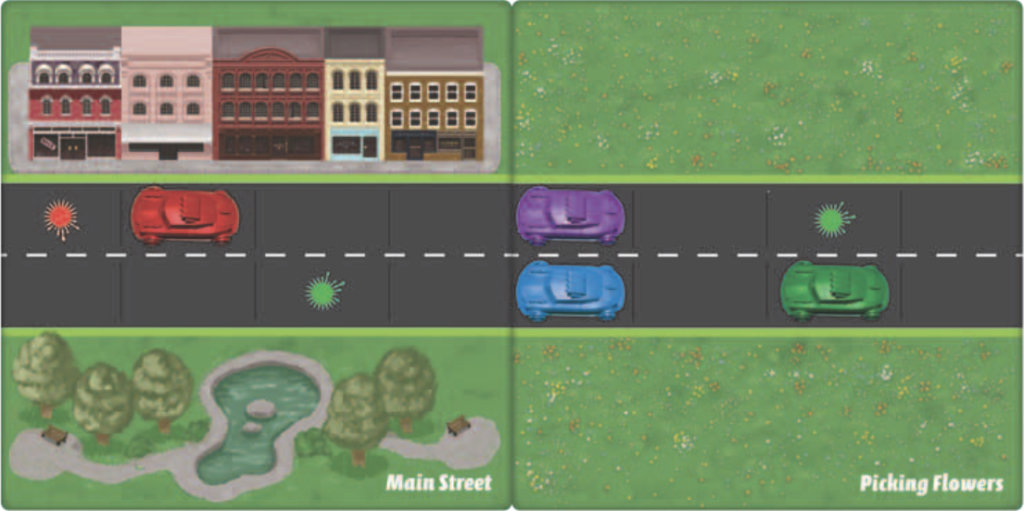
Example: The red car goes first because it is in front. The speeds of the purple car and the blue car are compared, and whichever is going the fastest goes first. Lastly, the green car performs its phase.
1. Draw Rally Cards
Draw three Rally cards and place them into your hand if you have less than five Rally cards in your hand. If you have five or more Rally cards in your hand you draw no Rally cards. For example, if you have 8 Rally cards at the start of your turn no Rally cards are drawn.
There is no hand size limit in the game.
Players with the Veteran Driver accessory always draw at least one Rally card.
2. Set Speed & Move
Speed is measured in 20 miles per hour increments and tracked in the speed log on the dashboard using a speed indicator counter. You may increase your speed by 20 MPH or decrease by up to 40 MPH.
For every Rally card discarded from your hand you may increase your acceleration or deceleration by 20 MPH.
You may not drive slower than 20 MPH or faster than 200 MPH.
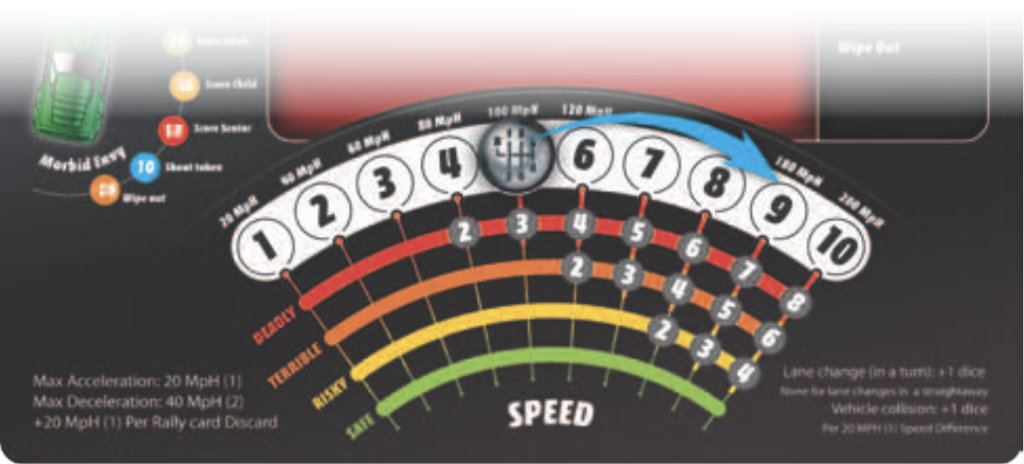
Example: A player traveling at 100 MPH(5) discards three Rally cards to increase his maximum acceleration from 20 MPH to 80 MPH. The speed indicator counter is moved from the 100 MPH(5) box to the 180 MPH(9) box.
Movement
After setting your speed, move one space for every 20 MPH your vehicle is traveling. Road spaces are separated with black lines and the edge between two road tiles separate spaces. Only one player may occupy a road space.
Movement is always performed forwards or forward-diagonally. You may move diagonally between two cars.
You may not move sideways or backwards.
You must complete your entire movement and cannot cut it short to avoid danger or get into firing position.
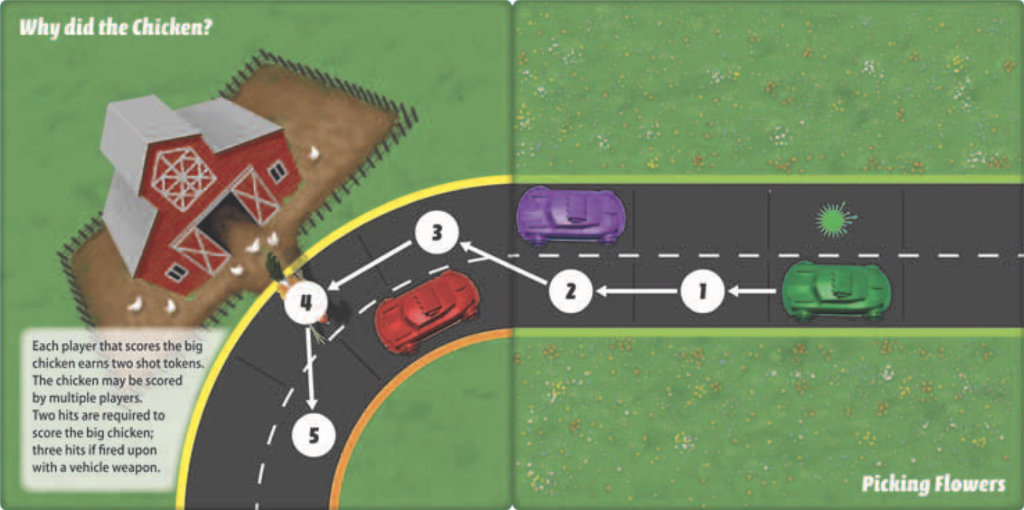
Example: A player is traveling 100 MPH so he must travel five spaces. The car moves forward into spaces one and two, diagonally into three, straight into four, and finally diagonally into space five.
The Bend in the Road
Road tiles are revealed randomly as play progresses. As soon as a player moves onto the first space of the forward-most tile, that player immediately pulls the top road tile from the deck. The new road tile is added to the forward-most section of track. The new tile may not overlap or turn into existing tiles. Try flipping the tile to the left or right to see if it can be directed away from the existing track. If this does not work, draw another road tile. The tiles that can not fit are returned to the bottom of the road tile deck.
Some road spaces in the newly placed tile contain a colored splatter. Place a pedestrian of the same color in each of these spaces. If you are out of pedestrian of a specified color, replace it with another color of the foremost player’s choice.
The road tiles to the rear are removed from play and placed in the discard pile after all the cars have driven through it.
The player continues with his movement after the new tile is added.
Crash Checks
Whenever you enter a new space you use your dashboard to cross reference your current speed to the color along the outside of the road space (green, yellow, orange or red). This process is called a crash check.
Roll the number of dice listed in the table and discard one Rally card for every splatter rolled. If the value in the table is blank then no crash check is required and no crash dice are rolled.
A crash check is required for every space you enter during your turn.
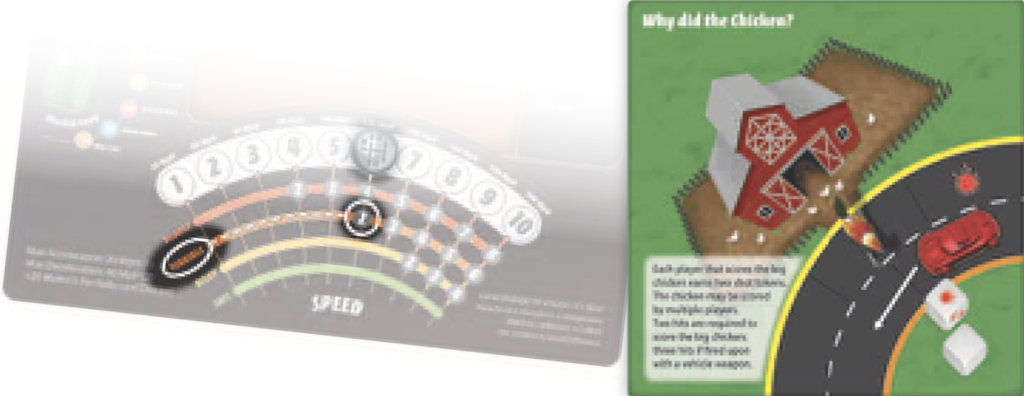
Example: A player is traveling at 120 MPH(6) and enters an orange road space. The 120 MPH(6) column is cross-referenced with the orange row for a result of two. Two dice are rolled with a result of one splatter. One Rally card is discarded and the player continues with the rest of his movement phase.
Taking It Safe
If you are not feeling lucky, you have the option of playing it safe instead of rolling the dice while making a crash check. Simply exchange each die with a Rally card from your hand. This exchange must take place before rolling any dice and all the dice must be replaced with cards.
Example: A player travels 140 MPH into a deadly turn and has a five-die crash check. The player decides not to press his luck and discards five Rally cards from his hand instead of rolling the dice.
Changing Lanes
Whenever you move diagonally and change lanes into a yellow, orange or red road space (turn spaces) add one to the number of dice rolled indicated on your speed log. No die is added if the die value on your speed log table is blank.
No die is added for changing lanes into a green (straightaway) road space.
Wipe out!
When you take damage and do not have enough Rally cards to discard the damage you wipe out and immediately:
- Reduce your speed to 20 MPH (1)
- Discard one mounted accessory card of your choice.
- Your movement stops and you may not score pedestrians for the rest of the turn.
- Add a Wipe out token to your dashboard.
- You can’t wipe out again until the following turn, even if you take additional damage this turn. You can only wipe out once per turn.
- After three Wipe out tokens are received, that player may not make any more pit stops. (Note: you still receive Wipe out tokens after the third token - you just can’t pit after three tokens.)
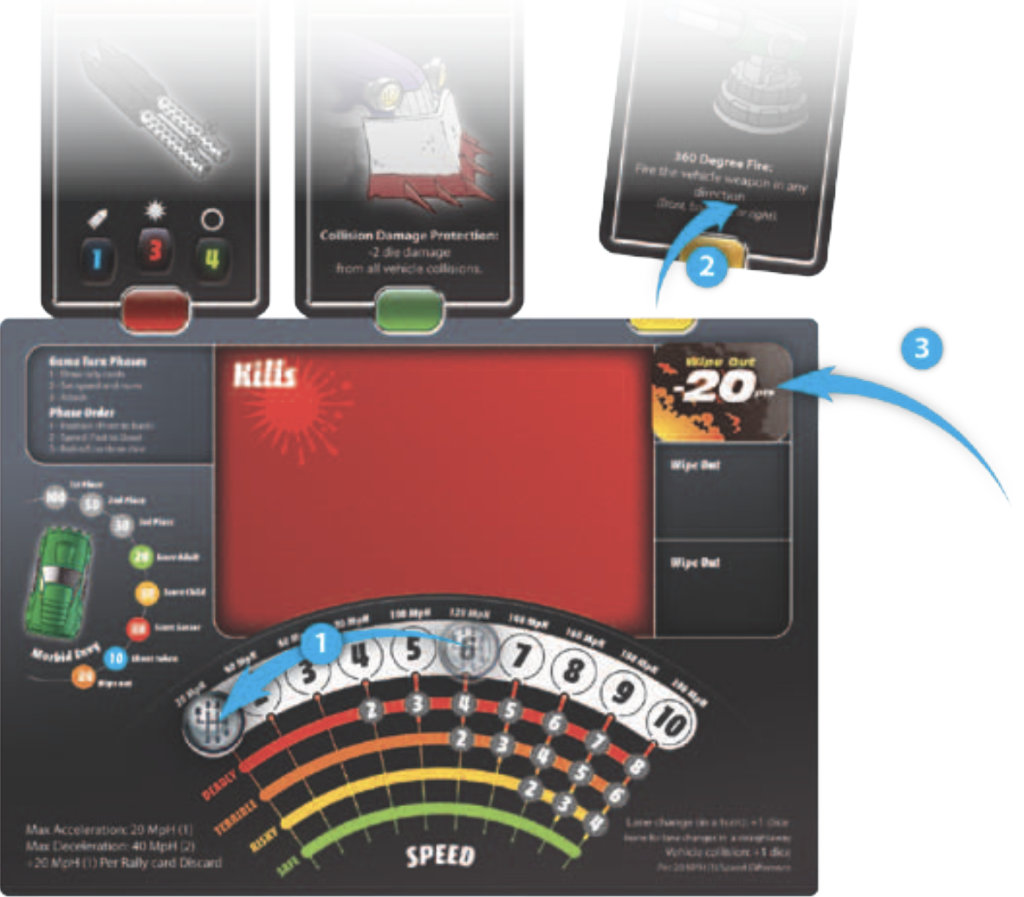
Example: A player with one Rally card left in his hand takes a corner too fast and performs a crash check, resulting in the loss of two Rally cards. The player discards his last remaining Rally card and wipes out. His speed is reduced to 20 MPH(1), he stops moving, chooses to discard his equipped turret accessory card and adds a wipe out token to his dashboard. The player’s turn is over and can not wipe out again until the following turn.
Wipe out Tokens
Wipe out tokens are placed in the three boxes on the right hand side of the dashboard. Every wipe out token subtracts 20 points from your score. Your dashboard can hold more than 3 such tokens.
Vehicle Collisions
Only one player may occupy a road space. When you try to move into an occupied space a vehicle collision takes place. Your vehicle ends its movement phase and you do not move into the occupied space.
You and the player you hit roll damage against each other from the collision. One die is rolled for every 20 MPH of speed difference, with a minimum of one die of damage. Lost Rally cards are discarded. After rolling and applying damage, the speeds of your vehicles are averaged together (rounded down).
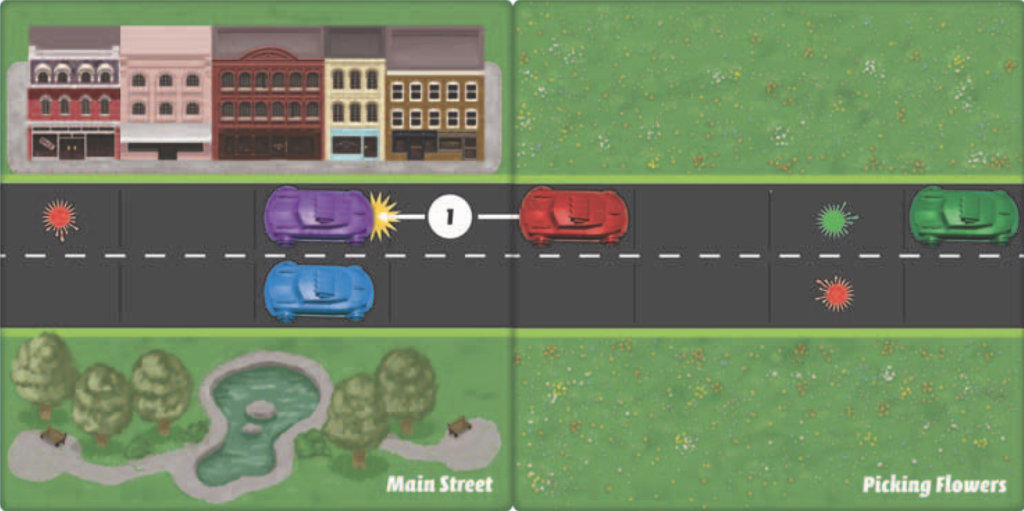
Example: Red car is traveling at 100 MPH and collides into purple car which is traveling at 60 MPH. Red car stops moving and both cars roll two dice of damage against each other. After the damage is applied the speeds of both vehicles are averaged together for a new speed of 80 MPH. This new speed is reflected on the dashboards of both cars.
Scoring Pedestrians
After performing the required crash check you may immediately attempt to score (run over) any pedestrians that occupy your road space. You receive one die to score a pedestrian plus any bonus dice for accessories. One additional die may be added for every Rally card you discard from your hand.
If you roll two or more hits the pedestrian is scored and the figure is placed in the “Kills” box on your dashboard. Missed pedestrians stay on the road space for others to score. You may not attempt to score the same pedestrian more than once.
You continue with your movement phase after attempting or succeeding to score a pedestrian.
There is no limit to the number of pedestrians you may kill in a turn.

Example: A player enters a space containing a child pedestrian. After performing any required crash checks, the player is given one die to score the pedestrian. He decides to purchase three more dice by discarding three Rally cards.
The dice are rolled and he scores three hits. The child pedestrian figure is placed in the kill box on his dashboard. The player continues moving into the next road space.
3. Combat
You may perform one combat action during the combat phase. The combat actions to choose from are:
- Attack another player with a vehicle weapon
- Play one attack Rally card
- Shoot a pedestrian with a vehicle weapon
- Perform a pit stop
Attack another player with a vehicle weapon
You may fire your mounted vehicle weapon at a single opponent if the following criteria are met:
Ammo: You must discard the number of ammo points listed on the accessory card with one or more Rally cards. The ammo value of each Rally card is listed on the top right-hand corner of each card. You do not get “change back” for discarding more ammo points than required.
Range: The target must be within the maximum range of the weapon listed on the accessory card (in spaces). Spaces may be counted diagonally.
Firing Arc: The target must be in a road space in front of your car (straight or diagonally ahead).
Line of Sight: You must have an unobstructed view of the target. Determine this by drawing an imaginary line between the middle of your road space to the middle of the road space the target occupies. The imaginary line must not pass through any vehicle occupied space or exit the track. When line of sight is under debate, err on the side of fun and let them take the shot.
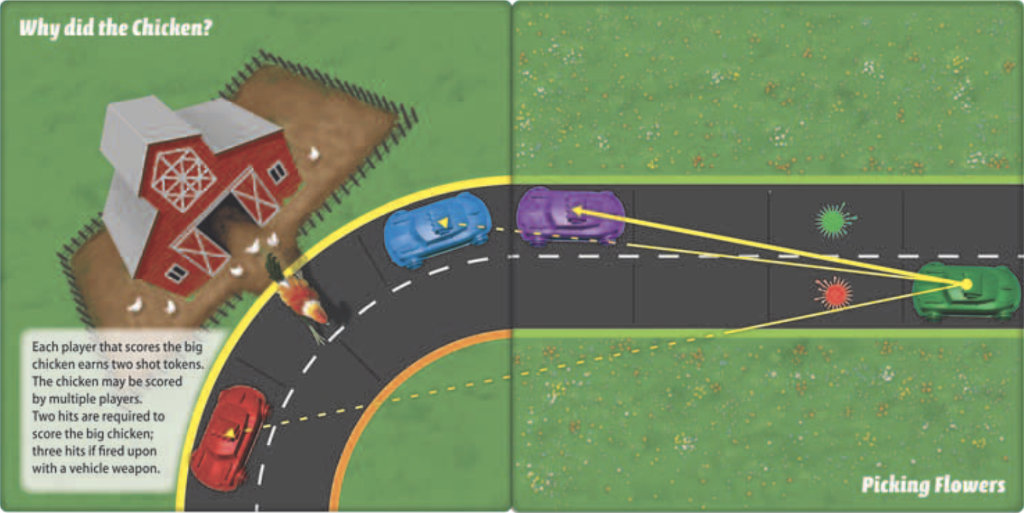
Example: Green car is shooting a rocket launcher with a range of six. He cannot shoot at the red car because the line of sight is blocked by the curve in the road. The green car cannot shoot at the blue car because line of sight is blocked by the purple car. However, the green car may shoot at the purple car (range of 3 spaces).
Roll Damage Dice
Roll the number of dice listed on the weapon accessory card. The target must subtract one Rally card from his hand for every that is rolled. The target may reduce the number of lost Rally cards with armor accessories or playing defensive Rally cards.
The target chooses which Rally cards are lost from his hand. The lost Rally cards are given to the attacker and added to his hand.
If the target does not have enough Rally cards to discard the damage caused he wipes out (see wipe out on page 5).
Example: you attack an enemy with a machine gun and score five hits. The target has ballistic armor so the damage is reduced to three hits. The target chooses three Rally cards from his hand and gives them to the attacker.
Shoot Tokens
The attacker is rewarded with one shoot token every time a weapon or Rally attack card damages a competing driver (making the player discard one or more Rally cards). More than one token is received if an attack damages more than one player (one token per player).
The Shoot token is placed in the player’s kill box and is worth 10 points at the end of the race.
You do not receive Shoot tokens for vehicle collisions or oil slicks that result in a crash.
Play Rally Attack Card
You may play one Rally attack card from your Rally hand. Attack cards have a red frame at the top. Follow the instructions on the card and discard after use.
Like weapon attacks, you receive your target’s lost Rally cards and earn a shoot token for damaging an opponent.
Shooting a Pedestrian
You may shoot a pedestrian with a vehicle weapon or Rally attack card if you have a firing arc, line of sight, range, and expend the ammo cards. You can shoot a pedestrian occupying your space if the attack has a 360 degree firing arc.
The pedestrian is scored if three or more hits are rolled; one more hit than required for running a pedestrian over with your car. Scored pedestrians are placed in your kill box.
You do not get a shoot token for shooting a pedestrian.
Pit Stops
You may discard a pit stop Rally card, draw one accessory card and reconfigure your car instead of attacking (see below).
Please note there is a pit stop road tile where you reconfigure your car while moving and still make an attack.
Cars with 3 Wipe out tokens cannot perform a pit stop.
Reconfiguring Your Car
You reconfigure your car by placing red, green and yellow accessory cards at the top of your dashboard with the accessory cards in your deck. The colors at the bottom of each accessory card must match the color at top of the dashboard (green on green, red on red and yellow on yellow).
Damaged accessory slots cannot be equipped with an accessory.
End Game
The game ends one turn after three players have crossed the finish line on the “Finish Line” road tile or all players have crossed the finish line. Players who cross the finish line are removed from play and can not be attacked.
Players who cross the finish line first, second and third receive Place tokens.
Add up your points for every pedestrian scored and Shoot token along with the Place tokens for crossing the finish line 1st, 2nd or 3rd.
Subtract twenty points for every Wipe out token received during the race.
The player with the highest score wins. If players’ scores are identical at the end of the race, the player who crossed the finish line first is the winner. If neither have crossed the finish line flip a coin to determine the winner.
Example: A player crosses the finish line third (30 points) and earned three Shoot tokens (30 points). During the race he scored three adults (60 points), one child (30 points) and three seniors (150 points). The player wiped out two times (-60 points) The player’s total points are 240.
Variant Rules
Elimination
Your vehicle is destroyed after all three of your Wipe out slots on your dashboard are filled with Wipe out tokens. Your car is immediately turned upside down on the space where it is destroyed, acting as an obstacle. It will be removed when the tile is removed.
You retain all of your current points (don’t forget to subtract points from your Wipe out tokens) and are still eligible to win the game if you have the highest number of points at the end of the game.
Should a collision happen with a destroyed car, the player who collided will roll one die for each 20 MPH it is traveling, but it will not stop moving unless it wipes out.
Driver Skills
Each player may acquire a skill to use throughout a race. Deal each player 2 Skill cards out the of the deck of 12 cards. Each player should then choose one of those cards to use in the race. All players should keep their choices hidden until all players have chosen a skill: then everyone reveals their choice simultaneously.
Team Play
Divide the players into teams of two. The points for each team are added together to determine the winner. If you have an odd number of players, double the score of the player with no teammate.
Frequently Asked Questions
Q: Do I still draw a Rally card if I have a veteran driver and more than five cards in my hand?
A: Yes. A Veteran driver always allows you to draw at least one Rally card during the first phase of the game turn. If you have less than five Rally cards in your hand then you draw up to six cards.
Q: During a crash check one of my dice rolled comes up with two splatters, do I roll another die?
A: Yes. Anytime you roll two splatters on a die, no matter the occasion, you roll another die.
Q: What happens when I wipe out in a space with a pedestrian? Can I still score it?
A: No, cars that wipe out can’t score pedestrians for the rest of the turn.
Q: When using the Orbital Death laser card do I roll one die per player or one die and apply the result to all players? Also, do I get more than one Shoot token for damaging multiple players?
A: Roll a separate die against each opponent. You receive one token for each player you damage.
Q: Do I have to make crash checks in the spaces I jump with my jump jets?
A: Yes, jump jets allow you to move through occupied spaces. You must still make crash checks in all spaces. If you fail the crash check in the occupied space then you move to the last empty space you occupied before jumping.
Q: Can I choose to use the Play it Safe rule when encountering road hazards?
A: Yes, road hazards create crash checks. You may discard Rally cards instead of rolling the dice.
Q: Do I get extra points for destroying another driver?
A: Nope, only the glory.
Q: Do I get a Shot token for damaging another player with the Bump attack Rally card?
A: Yes because you are using an attack Rally card.
Credits
Road Kill Rally Game Design by Daniel George
Graphic design by Karim Chakroun
Illustration by Chris Quilliams, Edward Artinian, Karim Chakroun & Daisuke Shimizu
2010 © Z-Man Games Inc.
64 Prince Road, Mahopac, NY 10541
For any comments, questions or suggestions, please contact sales@zmangames.com